Allied Troops are Knee Deep in the War in Sicily
Palermo, Catania and Enna (Can. troops) are Hot Spots
Map of Canadian Operations in Sicily, 10 July to 17 August 1943. Map by
C.C.J. Bond, in C.P. Stacey, The Canadian Army 1939-1945: Official
Historical Summary (1948), DND. Red circle denotes Can. troops. GH
Introduction:
The Montreal Gazette ran a lot of stories concerning WWII, especially on a busy Saturday in July. Canadian war correspondents - producing newspaper articles at a very steady clip - kept Canada informed to a very good degree. As well, radio broadcasts became another significant aspect re reporting how Allied troops were progressing, and a few items will be shared in this entry about the Canadian role in getting "on the air" across Canada.
And what about the Canadian Navy boys working hard aboard landing crafts along the eastern shores of Sicily just south of Syracusa? Don't worry, I've got them covered. I've learned that CBC Radio was definitely in their area, i.e., GEORGE Sector, at Fontane Bianche, and I have a few lines to share about that connection later.
Now, for the news -
(After our initial landings) we moved into a limestone cave, dank and wet, but safe from bombs. We hung a barrage balloon over it, about 1,000 feet up, and one sailor got drunk and shot it down but we had 50 - 60 feet of limestone over our heads. We used a pail of sand saturated with gasoline to heat our meals on if any food was available.
I had 27 days at Sicily living on tomatoes and Bully Beef. I swore I would kick the first bull I saw in Canada - right in the posterior - if I got back. Everywhere I looked there were anti-personal hand-sized grenades that needed only to be touched to go off. They were built to maim and not kill because it takes men to look after the wounded, but if you’re dead, you’re dead. We threw tomatoes at a lot and exploded them in that manner. (page 33, "Dad, Well Done")
Wanted. More Italian troops!
Now, for the news -
Lionel Shapiro, author of They Left the Back Door Open (re Sicily WWII), and mentioned in the last entry as "missing in action" and "where the heck did he get to?", eventually settled into a lovely routine of sharing buckets of information with his readership in Montreal (and beyond). Here is a lead article re Monty's Eighth Army near Catania:
[About the last paragraph above: Would the majority of Sicilians have somewhat the same attitude today, i.e., "what is Italy's business/concern is not necessarily our business/concern?"]
Map focused on Catania. Modified from map at top of page.
The Eighth is halfway up the coast but not halfway done. GH
Canadian troops are featured below related to actions in Enna (see red circle in the centre of the map at top of page):
In the third-last paragraph above we read about the masterful use of "booby traps and demolitions" by the Germans, to be expected in the "Troina-Aderno (etc.) area" NE of Enna. If one looks at the map of Sicily below (SE of Enna), the GEORGE Sector aka Beach 44 can be found, home of the RCNVR volunteers connected to Combined Operations (UK organization), who transported all materials of war aboard their landing crafts (the 80th Flotilla of Canadian LCMs) for the use of Monty's Eighth Army.
Inside the red circle an arrow points toward Fontane Bianche, Beach 44, Sicily.
Dozens of members of the 80th, incl. my father, served in that area for 4 weeks
during July 1943, and made two adjoining caves near the beach their home.
About German "booby traps and demolitions" my father wrote the following in his Navy memoirs:
I had 27 days at Sicily living on tomatoes and Bully Beef. I swore I would kick the first bull I saw in Canada - right in the posterior - if I got back. Everywhere I looked there were anti-personal hand-sized grenades that needed only to be touched to go off. They were built to maim and not kill because it takes men to look after the wounded, but if you’re dead, you’re dead. We threw tomatoes at a lot and exploded them in that manner. (page 33, "Dad, Well Done")
Wanted. More Italian troops!
The Italian "powers that be" are targeting new recruits, while the American "powers that be" are encouraging Allied bombers to target Italy, including Rome:
Allied muscle (like a "sledgehammer") is gradually moving across Sicily. Where are Allied armies now and what are they doing?:
The War News Digest provides details from most of the war fronts, spread around the word:
A Nazi Military Governor announces executions are in order:
I have looked through the following book (copy from a Canadian navy veteran), and though some of the same ideas are listed, I do not think it is the same booklet described above. If you have a copy of a booklet that is described above, please let me know. Email me at gordh7700@gmail.com
The injured are well taken care of, but had a long journey to the nearest hospital:
re the third-last paragraph above, i.e., words from a Canadian Army captain from Salmon Arm, B.C.: "...as soon as we began disembarking, machine-gun fire opened. As far as I know we had two injured. One sailor was killed."
The captain had landed SW of Pachino (lower right corner of the map of Sicily at top of page). The sailor was likely British.
Canadian sailors landed British troops (in LCAs, i.e., landing craft assault), and then all materials of war (in LCMs, landing craft mechanised) as part of the 55th, 61st, 80th and 81st Flotillas of Canadian Landing Craft while serving Monty's Eighth Army south of Syracuse and north of Avola, on the lower third of the eastern coastline of Sicily.
As we read above, the Canadian troops landed SW of Pachino with some light opposition. Peter Stursberg, a renowned Canadian radio broadcaster, was close by, and describes the scene he encountered as follows:
I landed in Sicily without getting my feet wet. A large amphibious vehicle called a DUKW came alongside the LSI (Landing Ship, Infantry) when we ran into a sandbar and took us ashore. Already anti-aircraft guns were on the beach, and a bulldozer were widening the entrance to a small lane. Landing craft, including large tank-landing craft (LCTs), kept coming in and offloading troops and guns and tanks.
Operation Husky. Men of the Highland Division wade ashore from
landing craft during the landings in Sicily, 10 July 1943. Photo by
Wackett, F. (Sgt) No. 2 Army Film and Photo Section Credit - IWM
Peter Stursberg continues:
There was a great array of ships in the waters off Pachino Peninsula, a stretch of poor farm land that had been turned into the busiest port in Sicily. A combined operation* was confusion, organized confusion. I recall that I didn't know quite what to do. There was no transportation, no one to report to. Ross Munro had landed earlier, but I could not find him on the crowded beach. So I sat down on the sand and began to write my first story. It was scorching hot; and there was nothing in the sky, not even a cloud. The Sound of War, page 98
Caption: CBC personnel making sound recording – A. W. Holmes or Alex
McDonald, Peter Stursberg. Note: Photo likely taken in Sicily, inside a van
that carried carefully-manufactured recording equipment. GH
*combined operation - an exercise, raid or invasion that involved planned cooperation and co-ordination of efforts by the three major military forces, i.e., army, navy and air force. (Combined Operations is also a British organization, under the command of Lord Louis Mountbatten during Operation Husky and Baytown - invasions of Sicily and Italy, and more. My father took part in combined operations (e.g., exercises, raids, etc.) while a member of RCNVR and Combined Operations from 1941 - 1945, as did 950 - 1,000 other Canadian sailors.)
It is important to note that while many war correspondents followed the activities of the Allied armies in Sicily (e.g., U.S. troops making their way to Palermo, then to Messina; Canadian troops from west of Pachino to Enna to Mount Etna to Messina; British troops from Avola to Syracuse, Augusta, Catania to Messina), the activities of the Canadian Navy (RCNVR/Comb. Ops) upon which this site focusses, were taking place - for 4 weeks - along the eastern seaboard of Sicily, south of Syracuse. More about that to follow.
But first, some important news from Hollywood!
As many already know, the Canadian Army - after arriving in England - remained on the island for a long, long, long time before being called into action in Sicily. In Peter Stursberg's book, The Sound of War, which details his journey as a CBC radio reporter during WWII, comments are made about the waiting game Canadian troops endured:
Most of my work with the CBC Overseas Unit was reporting on the Canadian troops, visiting their camps, and covering their endless exercises, which were rehearsals for the real thing, as all exercises were. But when would the curtain rise? When would the balloon go up? That is what the rank and file wanted to know. They had been waiting around too long for the battle to begin.
After Dunkirk and the fall of France, the onus for the defence of the United Kingdom had fallen on the shoulders of the Canadians, who were the only fully equipped troops left in Britain. They were the guardians of the island fortress... (they) were stationed in the most vulnerable part of the country, the south coast, and they remained there for so long that the counties of Sussex, Hampshire, and Surry became know as the Canadian country. (page 67)
And now, finally, they're in the fight:
1939-1943: Training in England. Major Hoffmeister leads B Company (sans
drummer-boy) on a route march near the village of Limpsfield in the summer
of 1940. Click here for more details re the Seaforth Highlanders (Canadian)
Lionel Shapiro, of The Montreal Gazette, is keeping readers well-informed:
The "buzz" is as follows. Canadian 'Buzz' Beurling shot a lot of Italian and German planes down!
Click here for more about BUZZ from Canada's Aviation Hall of Fame.
I know this photo of a minesweeper isn't much to look at, but some the 950 - 1,000 members of RCNVR who volunteered for Combined Operations, got their first taste of the sea by spending a wee bit of time on a minesweeper off the coast of Halifax in late 1941. One such sailor, Lloyd Evans (from Ottawa) recounts the following:
A few items from the back pages of The Montreal Gazette close out this lengthy (hopefully informative) entry:
One airfield that the Allies took over was near the British landing site my father became very familiar with, on the east coast of Sicily about one mile from GEORGE Sector or Beach 44 (serviced by the 80th Flotilla of Canadian Landing Craft), between modern day Fontane Bianche and Cassibile). About a very memorable experience at the airfield my father wrote the following:
“I have no mess fanny or spoon,” I said, and the cook told me there were some fellows washing theirs up and to ask one of them for the loan of their mess fanny and spoon. So I walked over, tapped a man’s shoulder and asked if I could borrow his equipment. The man straightened up and said “sure” and it turned out to be Bill Donnelly from my own hometown of Norwich, Ontario.
I got my oppo, A/B Buryl McIntyre from the cave (at GEORGE Sector, Fontane Bianche) and did the vino ever run that night. Small world. So when we had had enough Bill crawled into his hole in the ground, covered himself with mosquito netting, and we headed back to the cave. Overhead, Beaufort night fighters were giving Jerry fighters and bombers hell. We felt the courage given us by the vino and slept quite soundly in our dank old cave ‘til morning rolled around again.
From "Dad, Well Done" my father's Navy memoirs.
More news clippings from The Montreal Gazette to follow.
Please click here to view Research: Three Months in the Mediterranean, 1943 (16)
K. Simpson's article continues:
Canadian artists and writers made a long-lasting contribution to the art of war:
Click here to view entries related to "the arts of war."
I think I've seen a better photo of the wreck below but cannot find it. So, I call for "Help Wanted." If you can find a clean photo of the damaged ship please let me know @ gordh7700@gmail.com
Two short articles, in conclusion:
More news clippings from The Montreal Gazette to follow.
Please click here to view Research: Three Months in the Mediterranean, 1943 (16)
Unattributed Photos GH






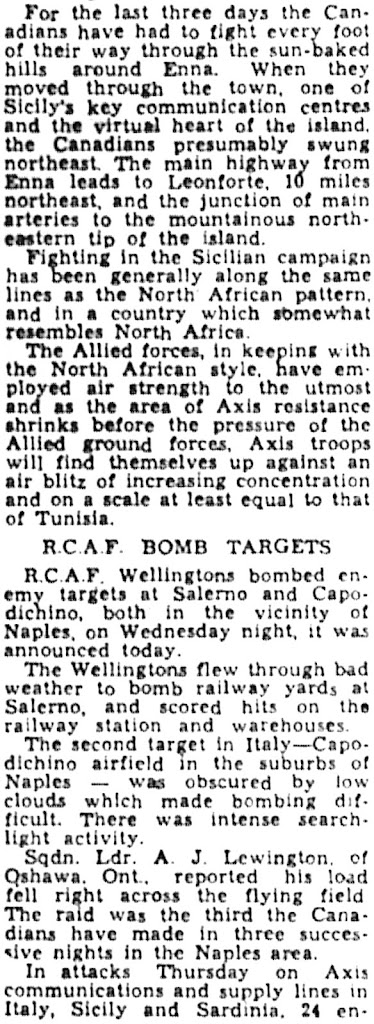









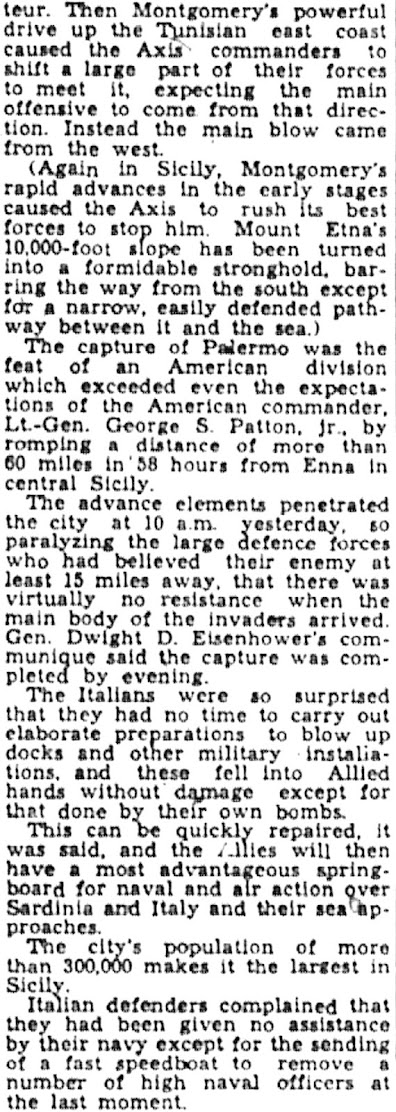

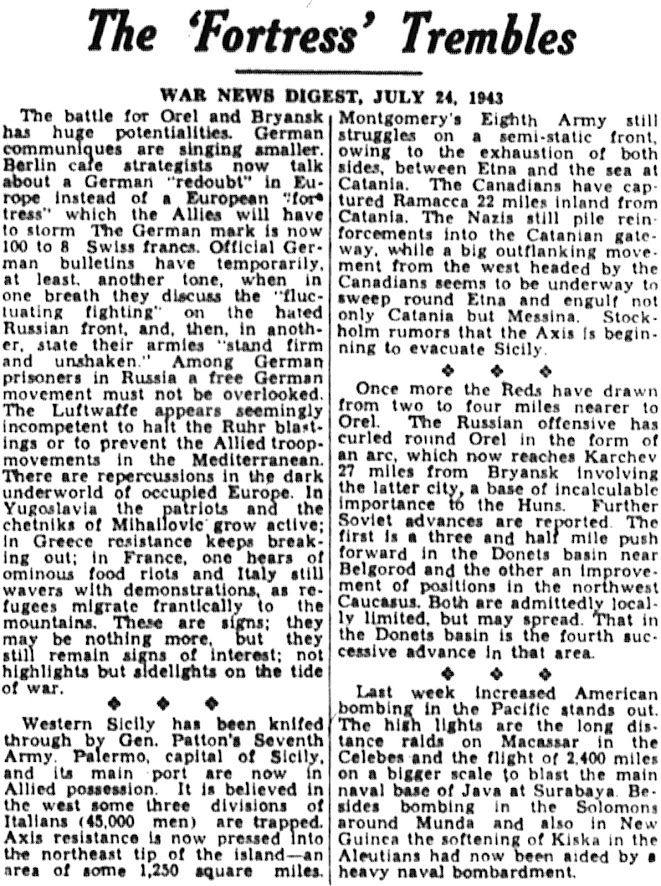












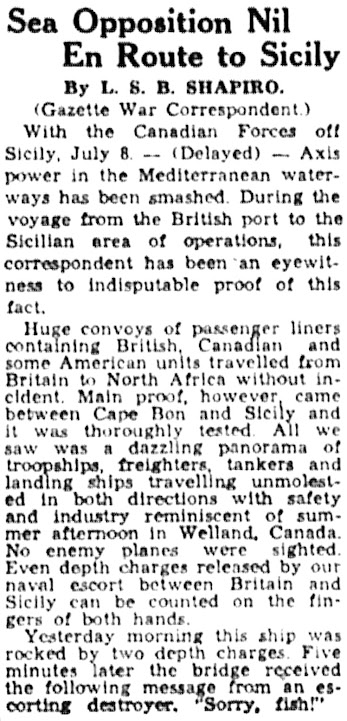






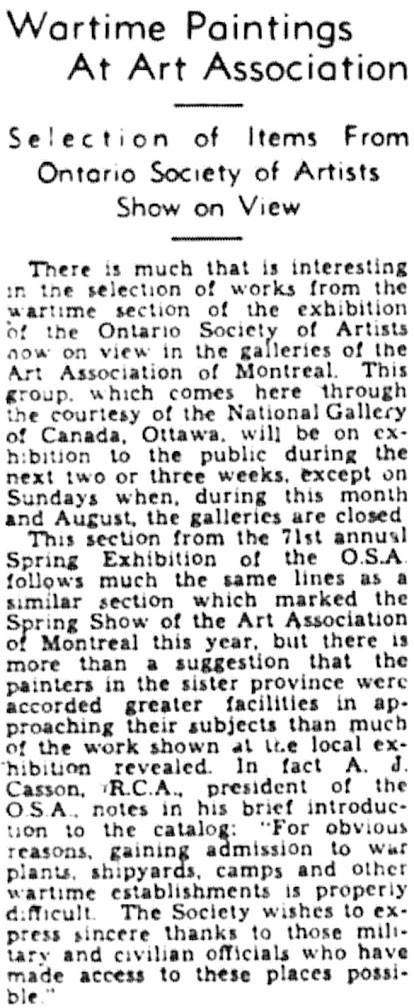









No comments:
Post a Comment